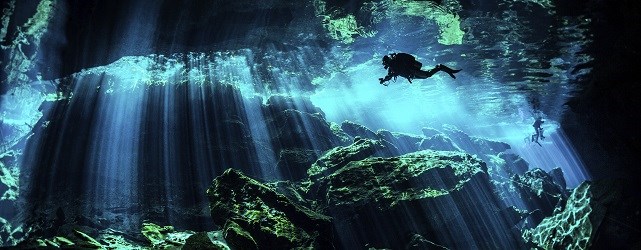On Thursday, November 29, at 7:30 pm, TV UNAM premiered a documentary that shows the underwater world hidden under the Yucatan Peninsula, the Great Mayan Aquifer. Narrated through the stories of explorers and scientists part of this great project in which National Geographic also participated. The viewer discovered the secrets of the flora, fauna and human settlements that the aquifer of the Yucatan Peninsula has benefited for thousands of years.
This is a documentary that places special emphasis on the exploration of caves and cenotes in the Yucatan peninsula, as well as on the archaeological remains that lie in the entrails of the earth sheltered by the great Mayan aquifer, which is like a dream of many geological ages, a dream that waits to be dreamed many times, but it is also a natural treasure of invaluable knowledge, of the present and from the past, still largely unexplored.
In the documentary, the underwater archaeologist Guillermo de Anda, guides us on a journey to the heart of the Earth, a huge network of flooded caves untouched by humans for thousands of years, much of the history of the Yucatan Peninsula, its wildlife and flora and geological changes, as well as the passage of the first Americans and the development of culture in the peninsula.

Cenote diving in the Yucatán Península
Photo: Journey Latin America
Through the stories of those who have dedicated their lives to explore and study the cave systems and cenotes of Quintana Roo and Yucatan, we get to know the importance of this aquifer for the life and culture of the Peninsula.
The Mayan aquifer is not only a magnificent natural laboratory to understand more about the history of the planet and the passage of pre-ceramic men in this region of America, it is also an excellent preservator of archaeological elements and remains of extinct fauna.
“From the archaeological point of view, we are interested in knowing how was the relationship that the great Maya civilization maintained with the aquifer, not only for the sustenance of life, but as an important part of its religious system. We are analyzing the relationship between the fauna and humans that inhabited this area in the Pleistocene, as well as the impact that anthropogenic activities currently have on the aquifer and the ecosystems to which it is connected “, explains Guillermo de Anda, INAH researcher, explorer and member of the National Geographic Society.
In addition, the aquifer of the Yucatan Peninsula means a unique source of information for science and thanks to the development and promotion of multidisciplinary projects such as the Great Maya Aquifer, we can assess the importance of exploring, understanding and conserving one of the reserves of water and the largest and most important cultural heritage in the world.

The Documentary Project of The Great Mayan Aquifer, developed and led by Dr. Guillermo de Anda, under the direction of Víctor Mariña as part of the TV UNAM team, the general production of Karla Ortega and with the script by Luis Gallardo, has been promoted by several higher education institutions such as the National Autonomous University of Mexico (UNAM), Aspen Institute Mexico, the National Institute of Anthropology and History (INAH), the Technological University of the Riviera Maya and the National Geographic Society.
The replay of this documentary will take place on Saturday, December 1st, 4:30 pm on tv.unam.mx
TYT Newsroom with information from milenio.com

